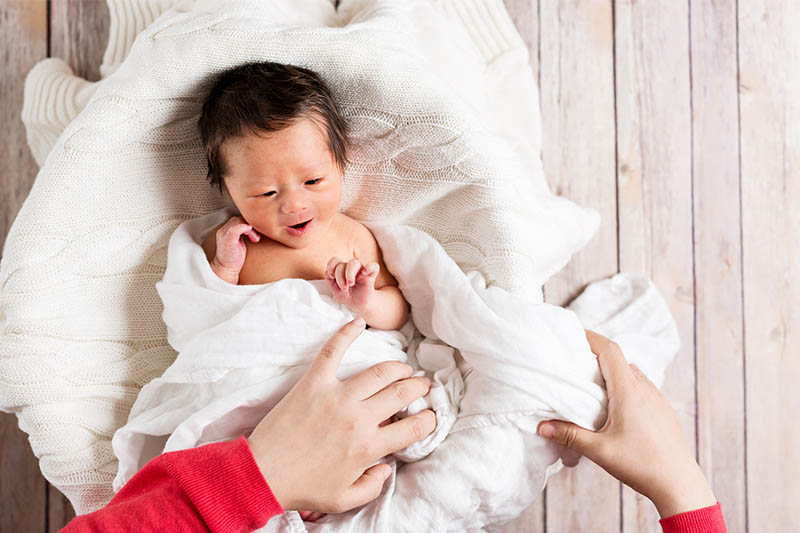Families For Life | Dressing a Newborn

DID YOU KNOW?
Cradle cap is the oily, scaly crust that babies sometimes get on their scalps, in their body folds and on their torsos. Although cradle cap looks uncomfortable, it doesn’t usually bother your baby.
READ MORE

Babies grow fast, so it’s best not to spend lots of money on outfits in the smallest sizes. In the first few weeks, your baby needs clothes that are comfortable and easy to get on and off.
Newborn clothes: sizes
Babies from 0-3 months can fit clothes up to 62cm in height, and babies from 3-6 months can fit up to 68cm in height. Some bigger newborns might be ready to go straight into a size 68cm. You might have to roll the sleeves up, but it won’t be for long.
Sizes vary between types of clothes and manufacturers, so it’s worth comparing clothes to other garments you already have, rather than relying only on the size on the label.
Because babies really do grow very fast, you might want to try buying the minimum number of clothes in each size.
How many clothes do newborns need?
You’ll need plenty of changes of clothes. As a guide, the following will see you through for a newborn baby:
six singlets
six jumpsuits
two nighties or jumpsuits for nightwear
three tops
two cardigans
three muslin (gauze) wraps
an infant sleeping bag (as an alternative to wraps)
a couple of cotton hats
a few pairs of socks
What kinds of clothes do newborns need?
Stretchy jumpsuits that button at the front are best, as well as tops with envelope necks, which are easier to get over your baby’s head. Jumpsuits with zips also make dressing your baby quick and easy.
It’s tricky to dress (and undress) an unsettled baby in something that’s difficult to get over the head, or that has a lot of buttons up the back.
Clothes should be soft, comfy and easy to take care of – you probably won’t have much spare time, so it’s best to avoid things that need handwashing and ironing.
It’s also important to look out for nightwear that has a low fire hazard label.
It’s best to avoid buying newborn clothes with beading, threads, ties, drawstrings and attachments.
How many layers of clothes do newborns need?
Newborn babies need to be kept warm. As a guide, dress your baby in the same number of layers you’re wearing, plus one extra layer for warmth.
Although it’s important to keep newborns warm, it’s just as important that your baby doesn’t overheat. So avoid wrapping your baby in blankets. Lightweight muslin and cotton wraps work well because they’re less likely to overheat your baby.
How to dress a newborn
Lots of newborns find the dressing and undressing experience upsetting. The quicker and calmer you are, the less stress for both you and your baby!
Here are some tips that might help:
Make sure the room is warm enough, then place your baby on a soft surface.
Put a diaper on your baby to avoid him urinating on you.
Stretch the neck of a singlet and, supporting your baby’s head, put the singlet on from the back. Be careful it doesn’t touch your baby’s face as you pull the front over her head – little babies can get very upset by clothes scraping their faces.
Do the reverse when undressing, once again trying not to let the clothes touch your baby’s face.
Gently place baby’s arms through the arm holes.
If you’re dressing your baby in a jumpsuit, unbutton or unzip it and lay him on top. Place his arms and legs into the holes and do up the zip or snap fasteners.
Make sure your baby’s legs and arms are clothed if she’s going out in the sun – but it’s better to keep her out of direct sun altogether if you can.
Try talking, singing nursery rhymes, smiling and making faces when you’re dressing your baby. This can distract your baby long enough for you to change him. Talking and singing are also good ways for you to bond with your baby.
How to wash newborn clothes
You can wash baby clothes with the rest of your laundry, but try to avoid using strong detergents and fabric softeners. These can irritate your baby’s skin.
Cloth diapers and clothes soiled with poo need to be soaked in diaper sanitiser before washing. Diaper sanitiser also makes a handy pre-soak once your baby is eating solids – even with a bib, your baby’s clothes will get covered in food and drink.
© raisingchildren.net.au, translated and adapted with permission
Explore more